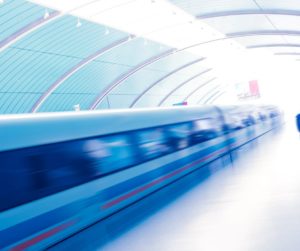Maglev Trains in Japan
The secret of Maglev trains’ magnetic levitation is kept within the tracks. The magnetized coil that runs along the track, called a guideway, repels the large magnets on the train’s carriage, allowing the train to levitate from 1 to 10 centimeters above the guideway. Once the train is in levitation, energy is supplied to the coils inside the guideway walls to create a unique system of magnetic fields that attract and propel the train along the guideway. The electrical current supplied to the coils in the guideway walls is constantly alternating to change the polarity of the magnetized coils.
Magnetic levitation trains float on a cushion of air, eliminating friction. This lack of friction and the aerodynamic designs of the trains allow them to reach unprecedented ground transportation speeds of over 500 km/h, but some magnetic levitation trains are capable of reaching even higher speeds, as demonstrated by the record set by Japan Railway in 2016 with a speed of 601 km/h.
Maglev projects in Europe
Although all Maglev projects are based on similar concepts, over time very differentiated prototypes have been developed. In Germany, engineers have developed an electromagnetic suspension (EMS) system called Transrapid. In this system, the bottom part of the train wraps around a steel guideway. The electromagnets fixed to the train carriage are directed upwards and towards the guideway, which causes the train to levitate about 1 centimeter above the guideway and keeps the train levitated even when it is not in motion. Other guide magnets incorporated into the train body keep it stable during the journey. Germany has demonstrated that Transrapid prototypes can reach 300 mph with people on board.

Magnetic levitation trains in Europe
On the other hand, Japanese engineers have developed an Electromagnetic Suspension (EMS) system, which relies on the repulsive force of magnets. The fundamental difference between the Japanese and German magnetic levitation train technologies is that Japanese trains use supercooled electromagnets and superconductors. This type of electromagnet can conduct electricity even after the electrical supply has been cut off. In the EMS system, which uses standard electromagnets, the coils conduct electricity only when an electrical supply is present. Cooling the coils to very low temperatures, the Japanese system saves energy. the cryogenic system used to cool the coils can be expensive and have a significant impact on construction and maintenance costs
Magnetic levitation trains in Italy
Italy has a long and varied railway history, but it has not yet experimented with magnetic levitation train technology, also known as maglev. This technology allows trains to travel at very high speeds, moving above the tracks thanks to a system of magnets.
Many countries have already adopted magnetic levitation trains, such as Japan with its maglev line of 430 km/h and China with several lines in operation and under construction. There are also projects under development in Europe, such as the German Transrapid that connects Shanghai airport with the city center.
In Italy, however, there are still no official plans for magnetic levitation trains. There have been some proposals in the past, such as the connection between Milan’s Malpensa airport and the city center, but these projects have never been realized.
Environmental sustainability and high costs
The reasons why Italy has not yet adopted this technology are multiple and complex. Firstly, the costs are very high and require a significant investment from either the state or private companies. In secondo luogo, ci sono preoccupazioni per la sicurezza dei passeggeri, dato che la tecnologia è ancora relativamente nuova e non ha ancora una lunga storia di successo.
Furthermore, there are also environmental concerns related to the construction of new railway infrastructures and their operation, especially considering that Italy already has an existing and functioning railway network.
However, many experts believe that maglev trains represent the future of high-speed rail transport, and could bring significant benefits in terms of efficiency, speed, and reduction of CO2 emissions.
In summary, there are currently no official plans to introduce maglev trains in Italy, but the technology is still the subject of interest and debate among experts in the transport industry.
Gesa Industry is always at the forefront of innovation and technology.
Gesa Industry closely follows all innovative projects for public transportation and has always accompanied the decisive progress of the sector, positioning itself as a reliable partner for the development and construction of new interior models for trains.



